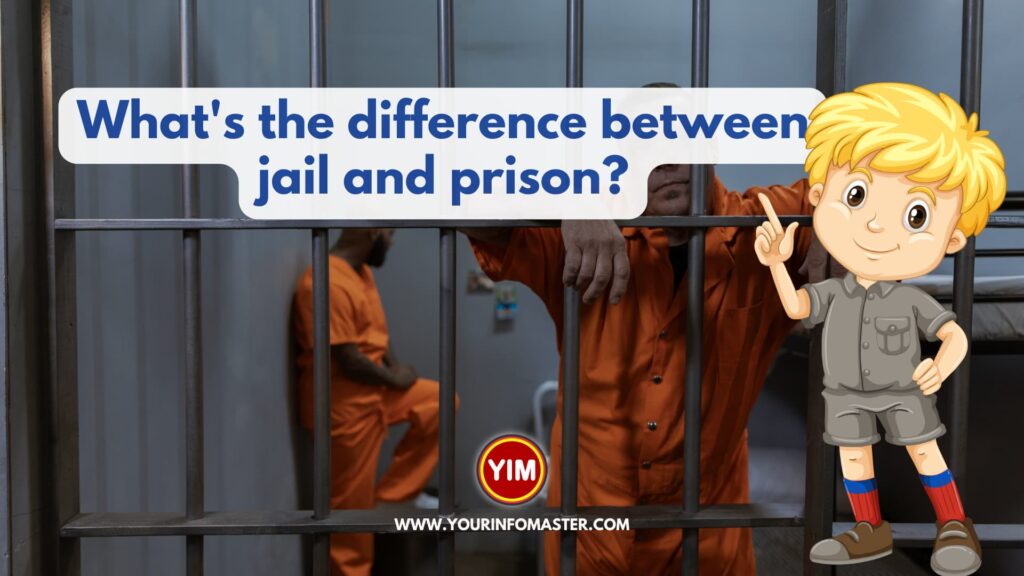I am going to explain the blog post “What’s the difference between jail and prison?“
When it comes to criminal justice, the terms “jail” and “prison” are often used interchangeably. However, these two terms actually refer to distinct types of facilities with different purposes and characteristics. It’s important to understand the differences between jail and prison, as they can have a significant impact on the rights and experiences of those who are incarcerated. In this blog post, we will explore the key differences between jail and prison, so that you can better understand the nuances of the criminal justice system.
Check also: Water Intake Calculator
10 Differences between jail and prison
Here is a list of 10 differences between jail and prison:
1. Purpose
The primary difference between jail and prison is their purpose. Jails are designed to hold individuals who have been arrested and are awaiting trial or sentencing, while prisons are designed to hold individuals who have been convicted of a crime and are serving a sentence.
2. Length of Stay
Jails typically hold inmates for shorter periods of time than prisons. While some inmates may be held in jail for several months or even years, the average length of stay is often less than a year. In contrast, prisons are designed to hold inmates for much longer periods of time, sometimes decades or even life.
3. Type of Offense
Jails typically hold individuals who have been arrested for minor offenses, such as traffic violations or misdemeanors. In contrast, prisons hold individuals who have been convicted of more serious offenses, such as felonies.
4. Security Level
Jails tend to have lower levels of security than prisons. While some jails may have maximum-security units for particularly dangerous or high-profile inmates, the majority of inmates in jail are housed in minimum or medium-security units. Prisons, on the other hand, typically have multiple security levels, ranging from minimum to maximum security.
5. Size
Jails are generally smaller than prisons, both in terms of the number of inmates they hold and the physical size of the facility. Prisons are often much larger, with some holding thousands of inmates.
6. Staffing
Jails are typically staffed by local law enforcement agencies, such as sheriff’s offices or city police departments. In contrast, prisons are typically run by state or federal government agencies and employ a larger number of staff, including correctional officers, medical personnel, and administrative staff.
7. Funding
Jails are generally funded by local governments, while prisons are funded by state or federal governments.
8. Access to Programs
Because jails are designed to hold inmates for shorter periods of time, they often have limited access to educational or rehabilitative programs. Prisons, on the other hand, typically offer a range of programs designed to help inmates develop job skills, address substance abuse issues, and prepare for life after release.
9. Contact with the Outside World
Inmates in jail often have more contact with the outside world than those in prison. They may be able to receive visits from family and friends more frequently, and they may be allowed to make phone calls or send emails more often. In contrast, inmates in prison may be limited in their contact with the outside world, particularly if they are in maximum-security units.
10. Release
When an inmate is released from jail, they are typically released directly back into the community. In contrast, inmates in prison may be released on parole, which involves a period of supervision and monitoring after their release.
Conclusion
In conclusion, although jail and prison may seem similar, there are several significant differences between the two. Jails are typically run by local law enforcement agencies and house individuals who are awaiting trial or serving shorter sentences, while prisons are state or federal institutions that house individuals who have been convicted of more serious crimes and are serving longer sentences. The conditions and services available in each may also differ, as well as the security levels. Understanding the differences between jail and prison is important for those who may be facing criminal charges, as well as for those seeking to understand the criminal justice system as a whole.
If you really enjoyed the article “What’s the difference between jail and prison?,” then I would be very grateful if you’d help it spread by emailing it to your friends or sharing it on Twitter, Instagram, or Facebook. Thank you!
Have you read “What’s the difference between jail and prison?“ Which of these blogs are you reading, and how is it similar to one of them?

